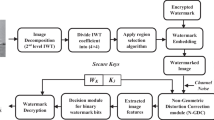Abstract
Watermarking is a process of secret information (watermark) insertion in the digital image, which later on helps in finding out the correct owner of that image. The insertion of watermark’s singular values into the host image provide a high value of capacity, robustness and imperceptibility but the scheme remain vulnerable towards false positive attacks. Alternatively, insertion of watermark’s principle components into the host image make the scheme secured towards security errors but it also reduces the robustness and imperceptibility of the scheme. The exact recovery of this information becomes even more difficult after attacks because attacks change the information even further. This eventually leads to low imperceptibility and robustness of scheme. In general, the optimization of embedding strengths for image watermarking focuses on the maximization of both imperceptibility and robustness equally. In doing so, often, imperceptibility suffers as it gets degraded beyond a certain limit (<35 dB). This degradation becomes unacceptable in many fields because important information of host image might get lost. In this study, the optimization is performed with a quality assurance so that imperceptibility of scheme does not fall below a user specific threshold. The proposed scheme shows a very decent performance after optimization.








Similar content being viewed by others
References
Akay B, Karaboga D (2015) A survey on the applications of artificial bee colony in signal, image, and video processing. Signal Image Video Process 9(4):967–990
Ali M, Ahn CW (2014) An optimized watermarking technique based on self-adaptive DE in DWT–SVD transform domain. Signal Process 94:545–556
Ali Musrrat, Ahn Chang Wook (2015) Optimized gray-scale image watermarking using DWT-SVD and Firefly Algorithm. Expert Syst Appl 42(5):2392–2394
Ansari IA, Pant M (2015) SVD watermarking: particle swarm optimization of scaling factors to increase the quality of watermark, In: Proceedings of fourth international conference on soft computing for problem solving. Springer, pp 205–214
Ansari IA, Pant M, Ahn CW (2016) Artificial bee colony optimized robust-reversible image watermarking. Multimed Tools Appl. doi:10.1007/s11042-016-3680-z
Ansari IA, Pant M, Ahn CW (2015) SVD based fragile watermarking scheme for tamper localization and self-recovery. Int J Mach Learn Cybern. doi:10.1007/s13042-015-0455-1
Ansari IA, Pant A, Ahn CW (2016b) Robust and false positive free watermarking in IWT domain using SVD and ABC. Eng Appl Artif Intell 49:114–125
Ansari IA, Pant M, Ahn CW (2016c) ABC optimized secured image watermarking scheme to find out the rightful ownership. Opt-Int J Light Electron Opt 127(14):5711–5721
Dugad R, Ratakonda K, Ahuja N (1998) A new wavelet-based scheme for watermarking images. In: Proceedings of the international conference on image processing, ICIP 98, vol 2. IEEE, pp 419–423
File T, Ryan C (2014) Computer and internet use in the United States: 2013. American Community Survey Reports
Ganic E, Eskicioglu AM (2005) Robust embedding of visual watermarks using discrete wavelet transform and singular value decomposition. J Electron Imaging 14(4):043004
Guo JM, Prasetyo H (2014) False-positive-free SVD-based image watermarking. J Vis Commun Image Represent 25(5):1149–1163
Henry ER, Hofrichter J (1992) [8] Singular value decomposition: application to analysis of experimental data. Methods Enzymol 210:129–192
Hsieh MS, Tseng DC, Huang YH (2001) Hiding digital watermarks using multiresolution wavelet transform. IEEE Trans Ind Electron 48(5):875–882
Jane O, Elbaşi E (2014) A new approach of nonblind watermarking methods based on DWT and SVD via LU decomposition. Turk J Electr Eng Comput Sci 22(5):1354–1366
Kankanhalli MS, Ramakrishnan KR (1999) Adaptive visible watermarking of images. In: IEEE international conference on multimedia computing and systems, vol 1. IEEE, pp 568–573
Karaboga D (2005) An idea based on honey bee swarm for numerical optimization. Technical report-tr06, Erciyes University, Engineering faculty, Computer Engineering Department, vol 200
Karaboga D, Akay B (2009) A comparative study of artificial bee colony algorithm. Appl Math Comput 214(1):108–132
Lagzian S, Soryani M, Fathy M (2011) A new robust watermarking scheme based on RDWT-SVD. Int J Intell Inf Process 2(1):22–29
Lin W, Tao D, Kacprzyk J, Li Z, Izquierdo E, Wang H (eds) (2011) Multimedia analysis, processing and communications, vol 346. Springer, Berlin
Ling HC, Phan RCW, Heng SH (2013) Robust blind image watermarking scheme based on redundant discrete wavelet transform and singular value decomposition. AEU-Int J Electron Commun 67(10):894–897
Ma J, Wang H (2003) Discrete wavelet transform (DWT). In: Proceedings of the third international conference on wavelet analysis and its applications. World Scientific, p 63
Mobasseri BG (2002) Digital watermarking in joint time-frequency domain. In: Proceedings of the international conference on image processing, vol 3. IEEE, pp III–481
Potdar VM, Han S, Chang E (2005) A survey of digital image watermarking techniques, In: 3rd IEEE international conference on industrial informatics INDIN’05. pp 709–716
Rastegar S, Namazi F, Yaghmaie K, Aliabadian A (2011) Hybrid watermarking algorithm based on singular value decomposition and radon transform. AEU-Int J Electron Commun 65(7):658–663
Shao-Zhang N, Xin-Xin N, Yi-Xian Y (2004) Digital watermarking algorithm based on LU decomposition. J Electron Inf Technol 26(10):1620–1625
Shensa MJ (1992) The discrete wavelet transform: wedding the a trous and Mallat algorithms. IEEE Trans Signal Process 40(10):2464–2482
Urvoy M, Goudia D, Autrusseau F (2014) Perceptual DFT watermarking with improved detection and robustness to geometrical distortions. IEEE Trans Inf Forensics Secur 9(7):1108–1119
Yeung MM, Mintzer F (1997). An invisible watermarking technique for image verification. In: Proceedings of the international conference on image processing, vol 2. IEEE, pp 680–683
Zhu JY, Krähenbühl P, Shechtman E, Efros AA (2016) Generative visual manipulation on the natural image manifold. In: European conference on computer vision. Springer, pp 597–613
Acknowledgement
This work was supported by Ministry of Human Resource Development, India.
Author information
Authors and Affiliations
Corresponding author
Rights and permissions
About this article
Cite this article
Ansari, I.A., Pant, M. Quality assured and optimized image watermarking using artificial bee colony. Int J Syst Assur Eng Manag 9, 274–286 (2018). https://doi.org/10.1007/s13198-016-0568-2
Received:
Revised:
Published:
Issue Date:
DOI: https://doi.org/10.1007/s13198-016-0568-2




